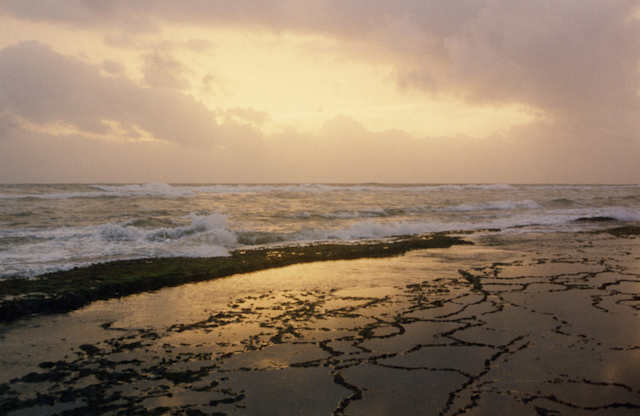Grey Noise, Dubai, 13 March – 13 May
Sagar is a quiet, painfully lovely show in which nothing much seems to happen. Despite a studio practice spanning over five decades, the Pakistani artist has, until recently, been known more for her pedagogy and committed feminist activism. Taking as its title the Hindi word for ‘sea’, Rukh’s first Dubai solo works as a confluence – perhaps even a sangam – of these multiple sides of her practice with a collection of watery vistas: coastlines, rivers, reefs, seascapes.
Smoky cerulean walls give the gallery vestibule a moody, atmospheric feel. The show opens with a mixed-media drawing on photographic paper, River in an Ocean 4 (1992). Rukh’s technique involves using photographic developer to expose ink and graphite; aided by judicious lighting, her method seems to illuminate the work from within. The video Gadani.2001.07.00–19.00 (2001), flickers on a boxy CRT monitor angled on the floor beside the drawing. As is the case with the photographs that comprise the bulk of the show, the title indicates the location, and sometimes time in which the footage was captured: here, a Pakistani beach. In these photographs, the sun sets over coppery waters in Goa, and casts the Burmese Irrawaddy river in something like Pantone’s 2016 colours of rose quartz and serenity, while the tide breaks over keloid scarlike rocks on Sri Lanka’s Beruwala beach, and a Nepalese lake curiously suggests shimmery crinkle chiffon. The images, taken between 1992 and 2005 during her travels around the subcontinent, are exhibited here – and in some cases, developed – for the first time. Less generously, the show carries a whiff of a direct-to-video style of release: an exhibition that seems cajoled out of an artist’s archive, conscious primarily of its future-historical importance.
Rukh is considered a pioneer of South Asian minimalism, and a large untitled (2003) drawing showcases her characteristic economy of form. Her line work is so spare, so subtle that it suggests a blank sheet of paper, and only upon coming much closer do her marks begin to materialise as a wavy horizon. The two drawings make no reference to a specific geography or aqueous terrain but rather document the political timbres of their time: the buoyant sense of possibility following the 1988 death of Pakistani dictator Muhammad Zia-ul-Haq and the ebbing of optimism in the tumultuous decade that followed.
The main gallery is painted the palest blue, and the overall effect is restive, even soothing. It would be easy to read this show as a meditation on time and transience or something equally – tryingly – universalised. Yet ‘it is not good for water to be so still that way,’ as Langston Hughes wrote in his poem Sea Calm (1926) and, indeed, there’s something deeply unnerving in the quietude of a placid sea, in the comfortable inertia of complacence. The show is by no means taut, but doesn’t quite suggest a beach holiday either. Rather, it feels like a testament to the slow, patient generosity of movement building. The kind that goes unannounced and unacknowledged, but is all the more crucial for that fact. And if that’s all there is, my friends, then let’s keep struggling and fighting and building.
First published in the Summer issue of ArtReview Asia
